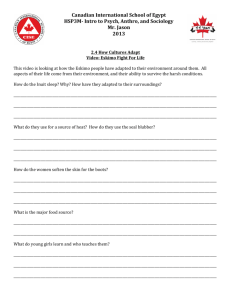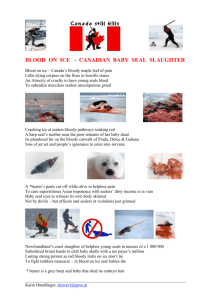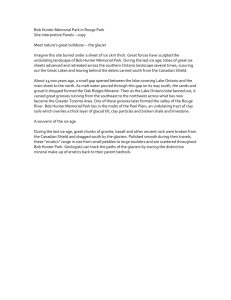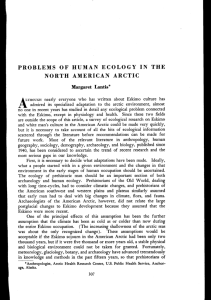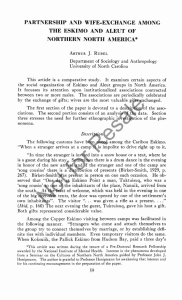Settlement
advertisement
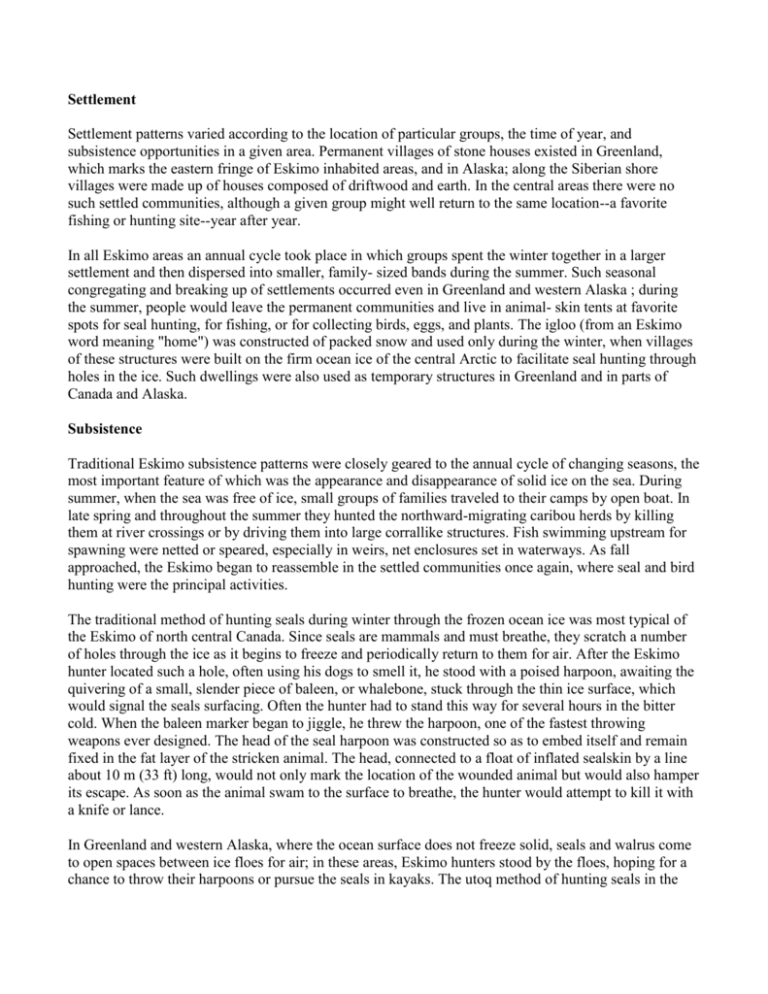
Settlement Settlement patterns varied according to the location of particular groups, the time of year, and subsistence opportunities in a given area. Permanent villages of stone houses existed in Greenland, which marks the eastern fringe of Eskimo inhabited areas, and in Alaska; along the Siberian shore villages were made up of houses composed of driftwood and earth. In the central areas there were no such settled communities, although a given group might well return to the same location--a favorite fishing or hunting site--year after year. In all Eskimo areas an annual cycle took place in which groups spent the winter together in a larger settlement and then dispersed into smaller, family- sized bands during the summer. Such seasonal congregating and breaking up of settlements occurred even in Greenland and western Alaska ; during the summer, people would leave the permanent communities and live in animal- skin tents at favorite spots for seal hunting, for fishing, or for collecting birds, eggs, and plants. The igloo (from an Eskimo word meaning "home") was constructed of packed snow and used only during the winter, when villages of these structures were built on the firm ocean ice of the central Arctic to facilitate seal hunting through holes in the ice. Such dwellings were also used as temporary structures in Greenland and in parts of Canada and Alaska. Subsistence Traditional Eskimo subsistence patterns were closely geared to the annual cycle of changing seasons, the most important feature of which was the appearance and disappearance of solid ice on the sea. During summer, when the sea was free of ice, small groups of families traveled to their camps by open boat. In late spring and throughout the summer they hunted the northward-migrating caribou herds by killing them at river crossings or by driving them into large corrallike structures. Fish swimming upstream for spawning were netted or speared, especially in weirs, net enclosures set in waterways. As fall approached, the Eskimo began to reassemble in the settled communities once again, where seal and bird hunting were the principal activities. The traditional method of hunting seals during winter through the frozen ocean ice was most typical of the Eskimo of north central Canada. Since seals are mammals and must breathe, they scratch a number of holes through the ice as it begins to freeze and periodically return to them for air. After the Eskimo hunter located such a hole, often using his dogs to smell it, he stood with a poised harpoon, awaiting the quivering of a small, slender piece of baleen, or whalebone, stuck through the thin ice surface, which would signal the seals surfacing. Often the hunter had to stand this way for several hours in the bitter cold. When the baleen marker began to jiggle, he threw the harpoon, one of the fastest throwing weapons ever designed. The head of the seal harpoon was constructed so as to embed itself and remain fixed in the fat layer of the stricken animal. The head, connected to a float of inflated sealskin by a line about 10 m (33 ft) long, would not only mark the location of the wounded animal but would also hamper its escape. As soon as the animal swam to the surface to breathe, the hunter would attempt to kill it with a knife or lance. In Greenland and western Alaska, where the ocean surface does not freeze solid, seals and walrus come to open spaces between ice floes for air; in these areas, Eskimo hunters stood by the floes, hoping for a chance to throw their harpoons or pursue the seals in kayaks. The utoq method of hunting seals in the spring was also distinctive of the more northerly Eskimo. Seeking warmth, seals often climb onto the surface of the ice to bask in the sun. A hunter would slowly creep toward a sleeping animal, either pushing a white shield of skin before him or else dressed and acting in such a manner that to the seal he would look like another animal. He would get close enough to fix a harpoon (or, after contact with Europeans, shoot with a rifle) before the seal, sensing danger, could scramble back into the water.
